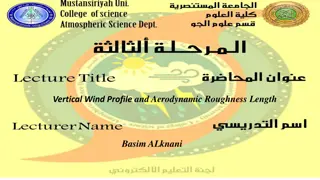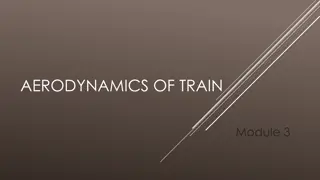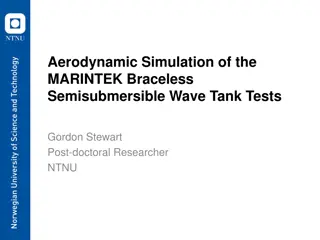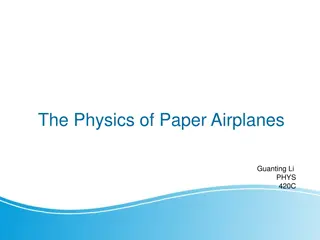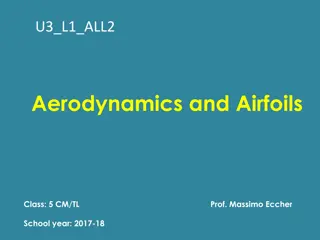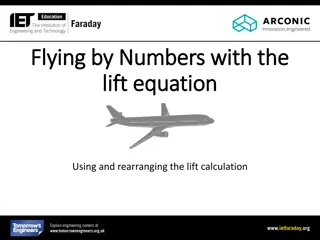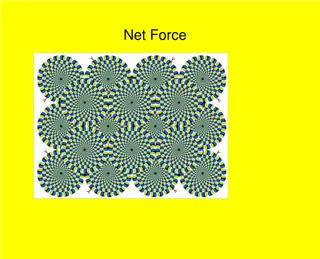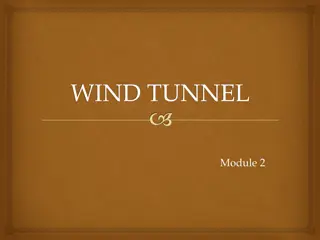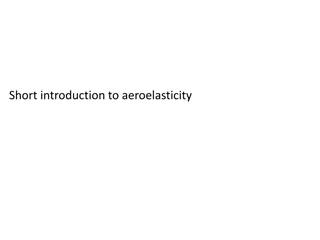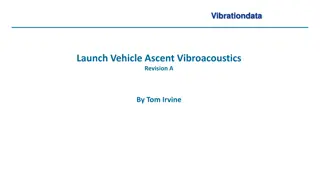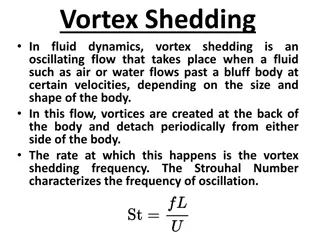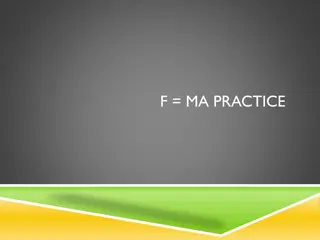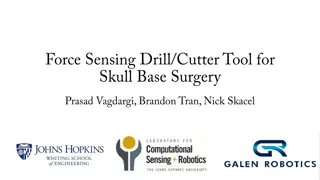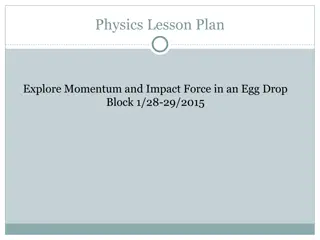Understanding Lift: The Aerodynamic Force in Airplanes
Lift is the aerodynamic force that opposes the weight of an airplane, keeping it airborne. It is generated by the motion of the aircraft through the air, with the wings playing a crucial role in lift production. The amount of lift depends on various factors like the shape, size, and velocity of the aircraft. Lift is created by deflecting the flow of gas around a solid object, following Newton's Third Law of action and reaction. Without a fluid medium like air, lift cannot be generated.
Download Presentation

Please find below an Image/Link to download the presentation.
The content on the website is provided AS IS for your information and personal use only. It may not be sold, licensed, or shared on other websites without obtaining consent from the author. Download presentation by click this link. If you encounter any issues during the download, it is possible that the publisher has removed the file from their server.
E N D
Presentation Transcript
2-Lift To overcome the weight force, airplanes generate an opposing force called lift. Lift is the: force that directly opposes the weight of an airplane and holds the airplane in the air. Is directed perpendicular to the flight direction .
Lift is a mechanical aerodynamic force produced by the motion of the airplane through the air. Lift is generated by every part of the airplane, but most of the lift on a normal airliner is generated by the wings.
Because lift is a force, it is a vector quantity, having both a magnitude and a direction associated with it. magnitude several factors including the shape, size, and velocity of the aircraft of the lift depend on
As with weight, Each part of the aircraft contributes to the aircraft lift force. Most of the lift is generated by the wings. Aircraft lift acts through a single point called the center of pressure. Lift acts through the center of pressure of the object and is directed perpendicular to the flow direction.
The center of pressure is defined: Just like the center of gravity, but using the pressure distribution around the body instead of the weight distribution. The amount of lift generated by an object depends on how much the flow is turned, which depends on the shape of the greater the flow turning, the greater the lift .
HOW IS LIFT GENERATED? Lift occurs when a moving flow of gas is turned by a solid object. The flow is turned in one direction, and the lift is generated in the opposite direction, according to Newton's Third Law of action and reaction. Because air is a gas and the molecules are free to move about, any solid surface can deflect a flow.
NO FLUID, NO LIFT Lift is a mechanical force It is generated by: The interaction and contact of a solid body with a fluid (liquid or gas). It is not generated by a force field, in the sense of a gravitational field , or an electromagnetic field, where one object can affect another object without being in physical contact.
For lift to be generated, The solid body must be in contact with the fluid: no fluid, no lift. The Space Shuttle does not stay in space because of lift from its wings but because of orbital mechanics related to its speed. Space is nearly a vacuum. Without air, there is no lift generated by the wings.
NO MOTION, NO LIFT Lift is velocity between the solid object and the fluid. generated by the difference in There must be motion between the object and the fluid: no motion, no lift. It makes no difference whether the object moves through a static fluid, or the fluid moves past a static solid object. Lift acts perpendicular to the motion.
Lift depends on The density of the air. The square of the velocity. The air's viscosity and compressibility. The surface area over which the air flows. The shape of the body, The body's inclination to the flow.
In general, The dependence on body shape, inclination, air viscosity, compressibility Is very complex. One way to deal with complex dependencies is to characterize the dependence by a single variable.
For lift, this variable is called: designated "Cl." The lift coefficient This allows us to collect all the effects, simple and complex, into a single equation.
The lift equation states that lift L is equal to the lift coefficient Cl times the density times half of the velocity V squared times the wing area A. L = Cl x A x 0.5 x x V2
The lift coefficient: Is a number that aerodynamicists use to model all of the complex dependencies of Shape. Inclination. Some flow conditions on lift. This equation is simply a rearrangement the lift equation where we solve for the lift coefficient in terms of the other variables. of
The lift coefficient Cl is equal to the lift L divided by the quantity: density times half the velocity V squared times the wing area A. Cl = L / (A x 0 .5 x x V 2)
The quantity : One half the density times the velocity squared is called the dynamic pressure q. So Cl = L / (q x A) The lift coefficient then expresses the ratio of the lift force to the force produced by the dynamic pressure times the area.
As a wing moves through the air, the wing is inclined to the flight direction at some angle. The angle between the chord line and the flight direction is called: Angle of Attack which has a large effect on the lift generated by a wing.
But just before lifting off, the pilot "rotates" the aircraft. The nose of the airplane rises, increasing the angle of attack and producing the increased lift needed for takeoff.
The magnitude of the lift generated by an object depends on the shape of the object and how it moves through the air. For thin airfoils, the lift is directly proportional to the angle of attack for small angles (within +/- 10 degrees). For higher angles, however, the dependence is quite complex.
As an object moves through the air, air molecules stick to the surface. This creates a layer of air near the surface called a boundary layer that, in effect, changes the shape of the object. The flow turning reacts to the edge of the boundary layer just as it would to the physical surface of the object.
To make things more confusing ,the boundary layer may lift off or "separate" from the body and create an effective shape much different from the physical shape. The separation of the boundary layer explains why aircraft wings will abruptly lose lift at high angles to the flow. This condition is called a wing stall.


